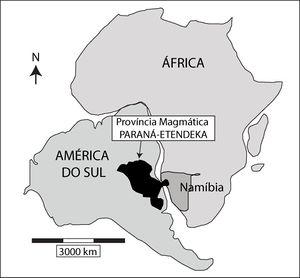Parana-Etendeka CBP
Parana-Etendeka Continental Basaltic Province represents one of the major volcanic events on Earth’s history. Is characterized by a fissural volcanism that occurred in the Early Cretaceous before the Gondwana rift and opening of South Atlantic Ocean. About 90% of the vulcanism is found in South America, covering 1,200,000 km² over the Parana Basin (Parana Continental Basaltic Province). The other 10% are in Etendeka (Etendeka Continental Basaltic Province), and Angola, Africa (Figure 1).
The Parana Continental Basaltic Province covers an area of 917.000 km² and has a volume of 600,000 km³. It is composed mostly (90% of volume) by basaltic and andesitic basalts rocks with a tholeiitic affinity. Acidic rocks occur locally in the upper volcanic pile. Chemically the basalts were divided in two groups based in the TiO2 contents: The first group occurs dominantly in southern areas and has TiO2 lower than 2 wt. %, the second group has high TiO2 (>2%) and is dominant in the northern portion of the Parana Basin. These two groups of basaltic rocks were sub-divided in six magma types: Gramado, Esmeralda and Urubici (Ti/Y<300) in the south, and Pitanga, Paranapanema and Ribeira (Ti/Y>300) in the northern magmas.
Acidic rocks are characterized by high crystallization temperatures. In the Paraná Basin, temperatures obtained by the coexisting pyroxenes method are 1,030 ± 38ºC. Chemcally the acidic rocks are also divided in two groups: 1) Palmas type, dacitic and rhyolitic rocks with low TiO2 and low contents of incompatible elements, dominant in the south of Parana Basin and is sub-divided in 5 sub-groups based on chemical characteristics: Caxias do Sul, Santa Maria, Anita Garibaldi, Clevelandia and Jacui. 2) Chapeco Type, porphyritic trachytes with high-TiO2, Ba, P, Zr and Sr. Present in the north and middle portions of the basin and is sub-divided in 3 sub-groups: Ourinhos, Guarapuava and Tamanara.
